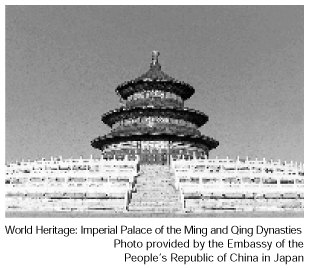| Home > Policy > White Paper, Notice, Announcement > White Paper > Japanese Government Policies in Education, Science, Sports and Culture 2000 > Part 1 Chapter 4 Section 4 3 | ||
The Protection of National Antiquities of the People's Republic of China Act was enacted in 1982. Facing a situation where many Chinese cultural assets were in danger, the Chinese government decided it would "mainly protect cultural assets and prioritize emergency assistance." From 1992 to 1995 the Chinese government made efforts to renovate, protect, and excavate cultural assets and ancient relics.
In 1995, the Chinese government proposed the principle of "effective protection, efficient use, and stronger management." The government emphasized that the state was responsible for protecting cultural assets, but that at the same time, society as a whole was also obliged to protect them. In other words, the Chinese government asked its citizens to engage in the protection of Chinese cultural assets. Based on this principle, each provincial administrative agency became responsible for protecting immovable cultural assets, such as buildings and ancient monuments.
Based on these fundamental policies and principles of the government, the State Bureau of Cultural Relics, as the supreme administrative agency for the protection of cultural assets, is responsible for designating and protecting cultural assets, governing museums, controlling the exodus of cultural assets abroad, and managing various research projects. In addition, the State Bureau of Cultural Relics has several institutions and organizations under its direct control. These include the Palace Museum, the National Museum of Chinese History, the National Museum of Chinese Revolution, and the Research Institution. The State Bureau of Cultural Relics also governs administrative agencies for protecting cultural assets in provinces, autonomous regions, cities under direct control, cities, xians (districts), local districts, and autonomous states.

In China, the designation system of important cultural assets is limited to tangible cultural assets, excluding collections held by museums or individuals. In addition to cultural assets with historical and artistic value, historical places that are related to the establishment of the People's Republic of China (the Chinese Revolution) are subject to protection as cultural assets.
At present, China has three designation systems: the National Emphatic Cultural Property Protect Units, the Historical Celebrated Castle Cities of China, and the National Emphatic Districts of Scenic Beauty. China's State Council officially proclaims these designations.
(a) National Emphatic Cultural Property Protect Units (since 1961)
(b) Historical Celebrated Castle Cities of China (since 1982)
(c) National Emphatic Districts of Scenic Beauty (sine 1982)
As of 1999, China has approximately eighteen hundred museums. China holds more than five thousand exhibitions with a total of one hundred million visitors each year.
| Back to Top | MEXT HOME |